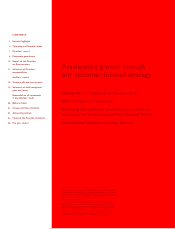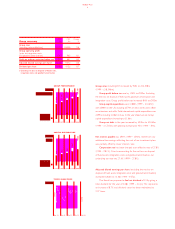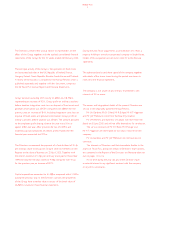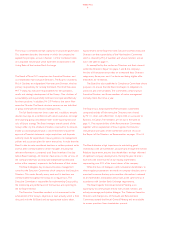Tesco 2000 Annual Report Download - page 7
Download and view the complete annual report
Please find page 7 of the 2000 Tesco annual report below. You can navigate through the pages in the report by either clicking on the pages listed below, or by using the keyword search tool below to find specific information within the annual report.
TESCO PLC
5
Joint ventures
Our total share of profits from joint ventures was £11m compared
to £6m last year.
Within this,Tesco Personal Finance has made good progress.
We have increased the offer and value for our customers and
incurred a small loss of £4m (1999 – £12m loss). Other joint
ventures contributed an operating profit of £15m this year.
Treasury management
and financial instruments
Group Treasury is formally authorised by the Board to manage the
Group’s treasury operations.The authority establishes the objectives
of Group Treasury and the strategies and policies to be applied. It also
defines limits to those operations, which are reviewed at least annually
by the Board and formally monitored. Group Treasury activity is
routinely reported to members of the Board and is subject to review
by the internal and external auditors. In accordance with Group
policy, Group Treasury does not engage in speculative activity.
The main financial risks faced by the Group relate to credit,
liquidity, interest rates and foreign exchange. Objectives, strategies
and policies for managing these risks are summarised below.These
objectives, strategies and policies are consistent with those in the
previous year.The balance sheet positions at 26 February 2000
are representative of the positions throughout the year.
Credit risk
The objective is to reduce the risk of loss arising from default by
dealing counterparties.The strategy is to avoid high exposure to
any single counterparty by spreading such risk across a number
of banks or similar institutions of high credit quality. For each
dealing counterparty, exposure limits, established normally by
reference to the major credit rating agencies and by deal type,
are reviewed at least annually by the Board. Mandates, defining
the Group’s dealing practices are agreed with these institutions
prior to deals being arranged.
Liquidity and interest rate risk
The objective is to ensure continuity of funding at low cost and
to avoid significant exposure to changes in interest rates.The
strategy is to maintain a portfolio of debt that is commensurate
with future cash generation and complements the Group’s trading
operations by reducing overall business risk.
Operating subsidiaries are financed by a combination of retained
profits, bank borrowings, commercial paper, medium term notes,
long-term debt market issues and leases.
Exposure to debt refinancing risk is managed through modest
gearing and adequate interest cover; by arranging for short-term
borrowings and commercial paper issuance to be fully backed by
committed bank facilities; by limiting the amount of debt repayable
in any one year; and by smoothing the debt maturity profile and
extending it in line with increased gearing levels.
At the year end, undrawn committed bank facilities amounted
to £765m (1999 – £510m) of which £110m (1999 – £25m) expire
within one year, £55m (1999 – £210m) between one and two years
and £600m (1999 – £275m) in more than two years.
Derivatives, predominantly forward rate agreements and interest
rate swaps and caps, are used to establish our desired mix of fixed
and floating rate debt.The policy is to fix or cap between 30% and
70% of the interest cost on outstanding debt although a higher
percentage may be fixed within a 12 month horizon.
The average rate of interest paid during the year was 6.8%
(1999 – 7.1%). A 1% rise in interest rates would reduce profit
before tax by less than 2%.
Foreign currency risk
The objective is to reduce the risk to short-term profits of exchange
rate volatility. Relevant short-term transactional currency exposures
are therefore hedged.
The Group also seeks to mitigate the effect of structural
currency exposures by borrowing, where cost effective, in the
functional currencies of its main overseas operating units. In
managing its structural currency exposures, the Group’s objectives
are to maintain a low cost of borrowing and retain some potential
for currency related appreciation while partially hedging against
currency depreciation.
Financial instruments used for these purposes are predominantly
foreign currency borrowings, forward exchange rate transactions
and swaps.




















